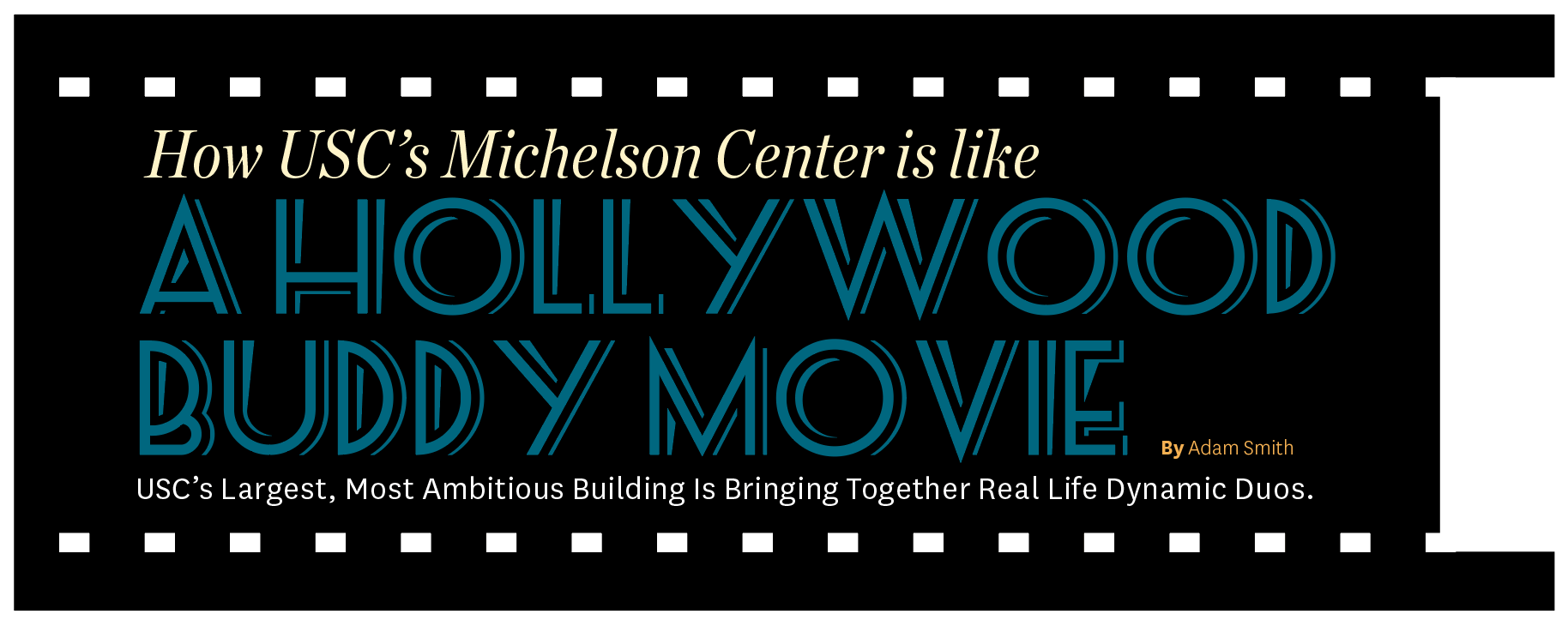How USC’s Michelson Center is like A Hollywood Buddy Movie
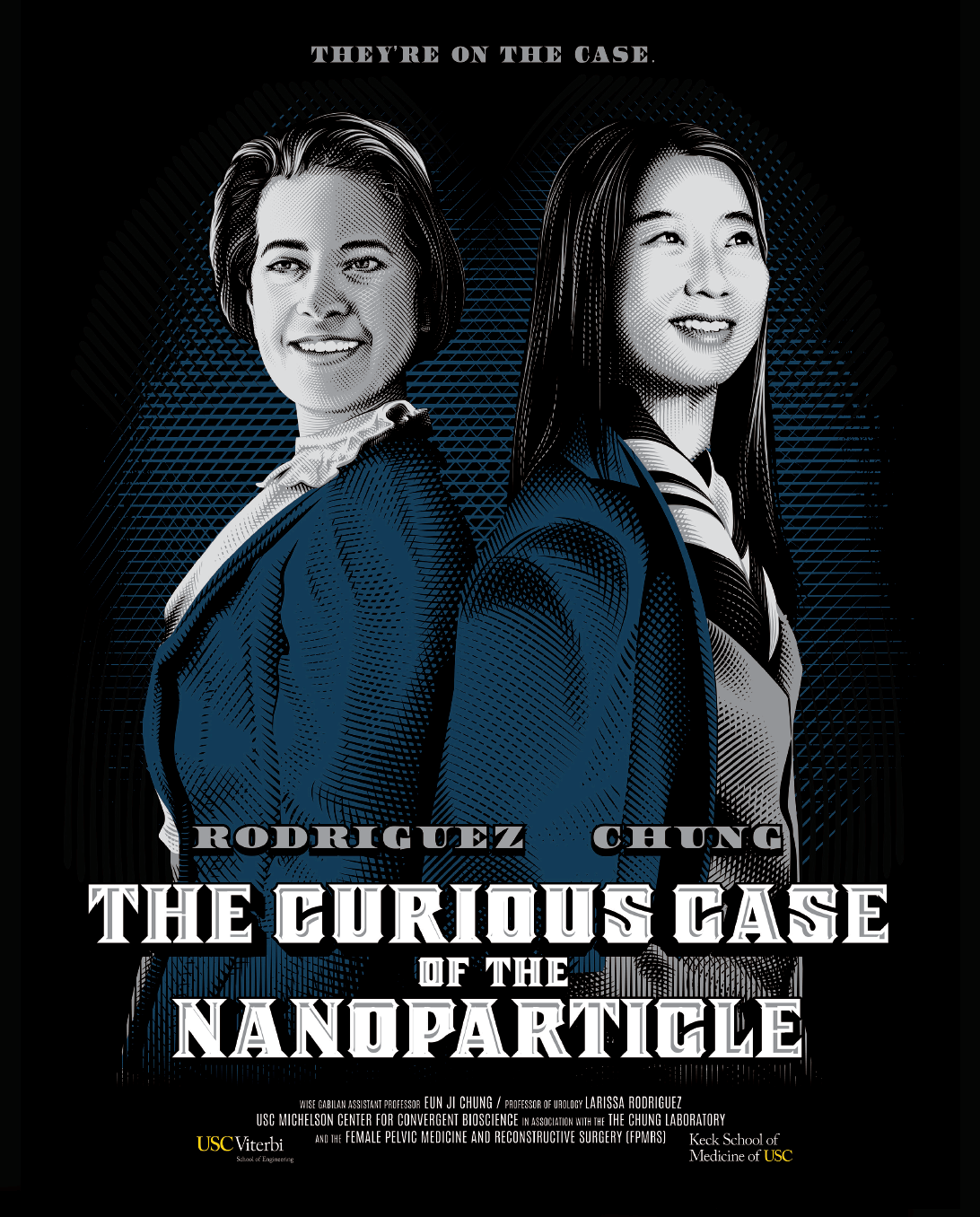
The Urologist and the Architect of Tiny Things
Larissa Rodriguez and Eun Ji Chung
In which one of the “top 35 bioengineers under age 35” (Chung) meets an internationally recognized surgeon and researcher in pelvic medicine and incontinence (Rodriguez).
Unique Skill Set:
Chung: We develop nanomaterials and scaffolds that can be injectable and regenerate smooth muscle cells for long-term urinary incontinence repair.
Rodriguez: As a practicing urologist, I have spent over 20 years treating women with stress incontinence. I understand how impactful this is for women and the limitations of our current treatments. I have developed unique animal models of stress urinary incontinence, which allow us to test out interventions.
How They Met:
Rodriguez: I was looking forward for USC to have an expert in biomaterials to collaborate in tissue engineering projects. I knew Dr. Chung was coming and went to a lecture she gave at the Broad CIRM Center months before she moved to USC. We briefly connected there, but really, it was by email that we made connected after her arrival.
Mission:
Rodriguez: We are trying to develop a minimally invasive durable treatment for stress urinary incontinence by restoring the normal function of the urethra, which is lost or affected after vaginal deliveries, age, menopause, etc.
The Stakes:
Chung: I’ve learned urinary incontinence can affect the majority of women after childbirth, hence it’s motivating to know that this work can help many women after a very important, natural and meaningful event in their lives.
Rodriguez: Urinary incontinence affects up to 13 million people in the United States, and 200 million worldwide. The condition affects quality of life but also has other significant detrimental health effects. I see women with urinary incontinence every day in my practice. Many are embarrassed and do not talk to even their family members about their condition, and suffer in silence. I want to empower women to take back their lives by treating this highly prevalent condition.
Unique Personality Traits:
Chung: I read a lot of autobiographies and biographies. For example, “When Breath Becomes Air” by Paul Kalanathi, about a Stanford-educated neurosurgeon who finds himself with terminal cancer.
Rodriguez: I like music and love to dance. Growing up, I was a professional ballet dancer. I was a member of the Ballets de San Juan in Puerto Rico. I don’t dance ballet anymore, but I love to dance to all kinds of music, including salsa.
Quotable:
Chung: The beauty of nano- and biomaterials is that you can adjust their chemical structure and architecture to achieve a biological outcome for a tailored clinical application.
Research success story:
Rodriguez: We have developed an injectable biomaterial that can be delivered easily into the urethra in the office. This material is compatible with cells, allowing for potential cell base therapy, and also able to deliver growth factors to the damaged urethral tissue to enhance healing.
How USC Michelson will aid our convergence:
Chung: With the animal imaging facilities that are currently being built out, we will be able to characterize the effectiveness of our materials in vivo directly from materials synthesis to functional tests.
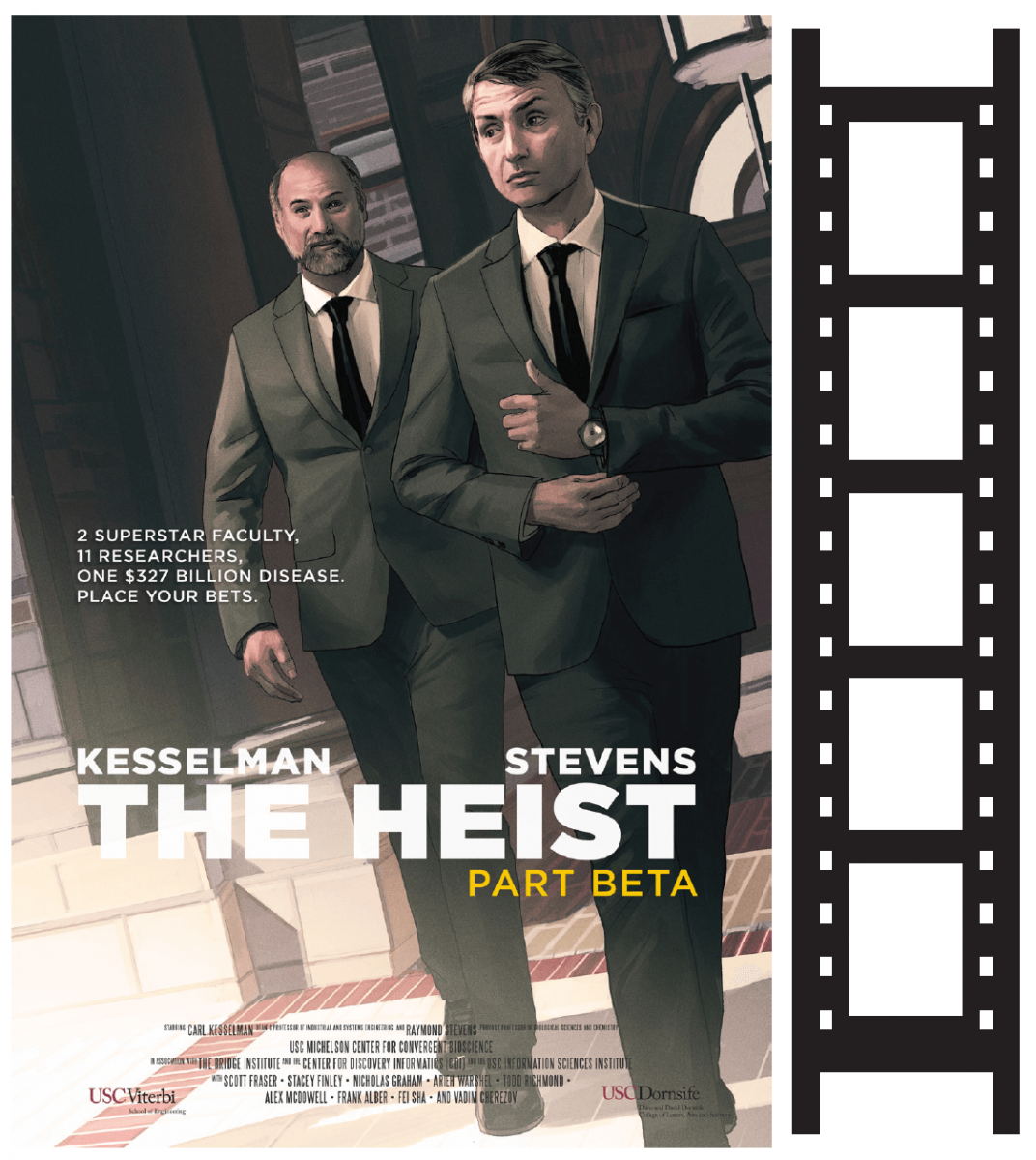
The M.C. (Master of Computers) and the Protein Whisperer
Carl Kesselman and Ray Stevens
In which a computer scientist who harnesses the power of thousands of global computers (Kesselman) meets a pioneer in the structure of proteins (Stevens), whose lab has created four different billion-dollar drugs.
Unique Skill Set:
Kesselman: I’m a computer scientist who has always been interested in how information technology can be used in novel ways to solve really hard problems. My work has contributed to three Nobel prizes.
Stevens: We are really good at understanding the 3-D structure of proteins and designing drugs that modulate their activity. Now, we are working on the 3-D structure of pancreatic beta cells to do the same.
How They Met:
Stevens: Over beers, we challenged each other to do better science and discovery.
Mission:
Kesselman: Our current work together is focusing on creating computational models for pancreatic beta cells. Among other things, this requires creating, assembling and interpreting lots of different types of data. I like to think that what we are doing is creating a new type of scientific instrument — a data “macroscope” — that will play a critical role in creating complex systems models from our various microscopes.
Stevens: Together, we are working to build a high-resolution model of the pancreatic beta cell, and then a high-resolution model of the pancreas. I want the model so I can design better and safer drugs to treat diabetes and pancreatic cancer. Carl helps us manage our data better so we can have more faith in how the data is integrated and how the cell models are influenced by new drug candidates.
The Stakes:
Kesselman: From a scientific perspective, having a model for beta cells will have a direct benefit to millions of people suffering from diabetes and cancer. My personal interest is in understanding humans and computers can work together synergistically to solve wicked hard problems, and as a result the work can have a much broader impact beyond just beta cells. This work is a perfect test bed for these ideas.
Stevens: My passion is to build molecules that help others. In this case, we are working to help those with diabetes or pancreatic cancer.
Unique Personality Traits:
Kesselman: I am a pretty serious musician. I play clarinet in the Santa Monica Symphony, occasionally give recitals and spend every summer attending a chamber music workshop where I get to be totally right-brained. I like to think that some artistic sensibility goes into the technology solutions that my group creates.
Stevens: I like to run ultramarathons — the last one was six days across the Sahara Desert in 125-degree heat and carrying all supplies. Now I’m working on climbing the seven highest peaks on the seven continents — the next one is in December on Antarctica, Vinson Massiff. Everest is planned for March 2020.
Quotable:
Kesselman: Your data collection methods and organization are crap.
Stevens: Engineers are uncomfortable with uncertainty. In biology, if we can get one out of 10 experiments to work, we’re happy!
Research success story:
Kesselman: We recently were co-authors on a paper with Professor Andy McMahon of the USC Center for Regenerative Medicine on parallels in kidney development in human and mouse. In this paper, we applied a number of the new ideas that we have developed to make the data in that paper completely citable and traceable all the way back to the microscope slide from which the data was obtained. This was as example of how we were able to change the methods of research to create an important research result.
Stevens: My lab has helped to develop four different billion-dollar molecules. The molecules help to treat phenylketonuria (PKU), cerebral palsy, diabetes, multiple sclerosis, influenza virus and inflammatory bowel disease. The most recent drug we developed was just approved by the FDA to treat PKU, a rare childhood disease. One recent molecule I am particularly excited about [that is] in clinical trials is to treat liver fibrosis, a rapidly growing disease that can lead to liver cancer.
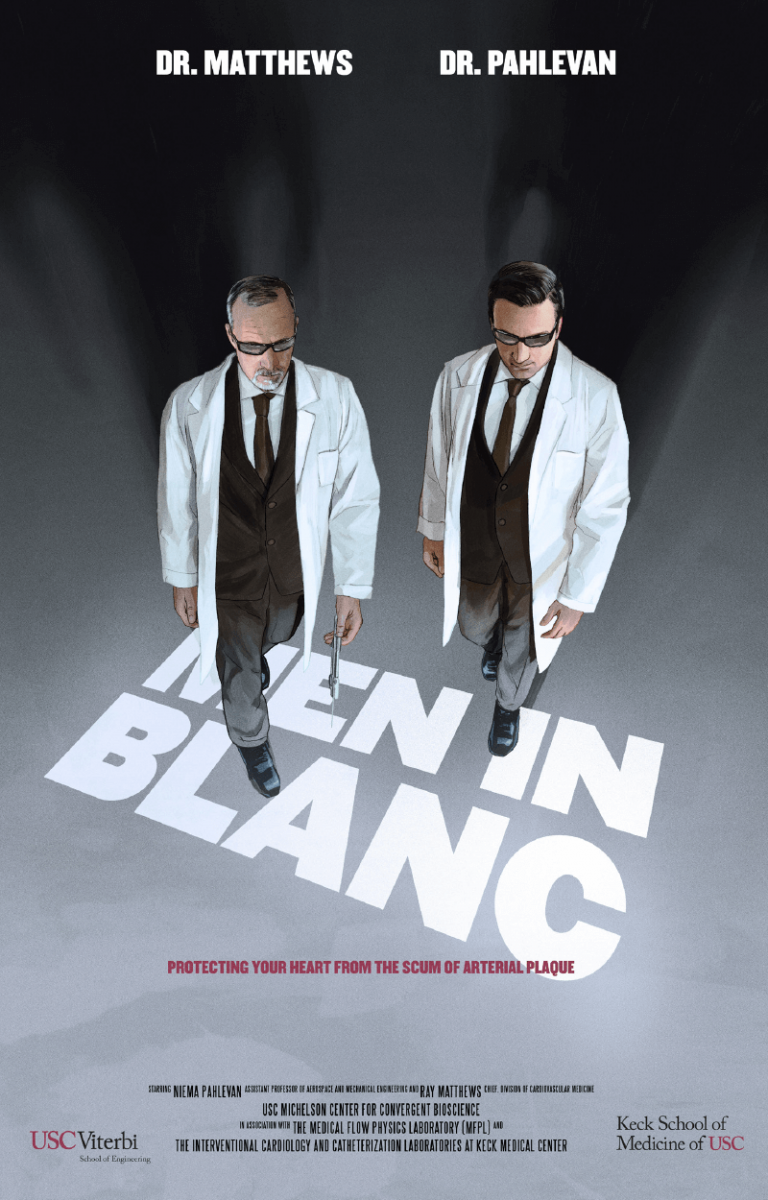
The Mechanical Engineer and the Heart Doctor
Niema Pahlevan and Ray Matthews
In which an engineer with an iPhone app that detects heart failure (Pahlevan) meets USC’s chief of cardiovascular medicine (Matthews), who has over 30 years of clinical human device trial experience.
Unique Skill Set:
Pahlevan: The brains and the mathematics behind the idea and the technology.
Matthews: Molds the device design to the clinical application. Performs the clinical testing.
How They Met:
Matthews: We were introduced through Niema’s mentor at Caltech by a mutual friend. Niema’s mentor said, “Ray, you really need to meet this guy, he is one of the smartest guys I have ever met.” The relationship with the mentor has been good, but little did I know at the time that the graduate student [Niema] would be the real find.”
Mission:
Pahlevan: To develop a way to measure the pressure inside the heart and help manage patients with heart failure using any smartphone.
The Stakes:
Pahlevan: This device could change the way we care for patients with heart failure. We could put the patients in charge of their therapy by allowing the adjustment of medications according to the pressure measured using an inexpensive method. Heart failure is the largest reason for medical admissions in the U.S. This could be big if we could reduce those admissions.
Unique Personality Traits:
Pahlevan: Quiet, reserved but persistent — like a pit bull on your pant leg when I have an idea. Played soccer professionally in my early 20s. Quit professional soccer career at the age of 23 to go to graduate school.
Matthews: Likes country music, born in Wyoming, loves sports of all kinds.
Quotable:
Pahlevan: Nearly 50 percent of heart attacks are silent — the heart is damaged, but people aren’t aware they just had a heart attack, so they don’t seek treatment to prevent future heart attacks. We are working to help doctors and our future app users identify silent heart attacks — and really, any heart failure — before they happen.
Research success story:
Matthews: Our collaboration started in 2012 and resulted in the breakthrough paper “Intrinsic Frequency for a Systems Approach to Hemodynamic Waveform Analysis with Clinical Applications.” Niema developed a new mathematical method called intrinsic frequency (IF) and we demonstrated the proof of concept for its clinical usefulness. It has been recently shown that by Niema that this method enables us to measure heart performance (ejection fraction of the heart) using an iPhone.
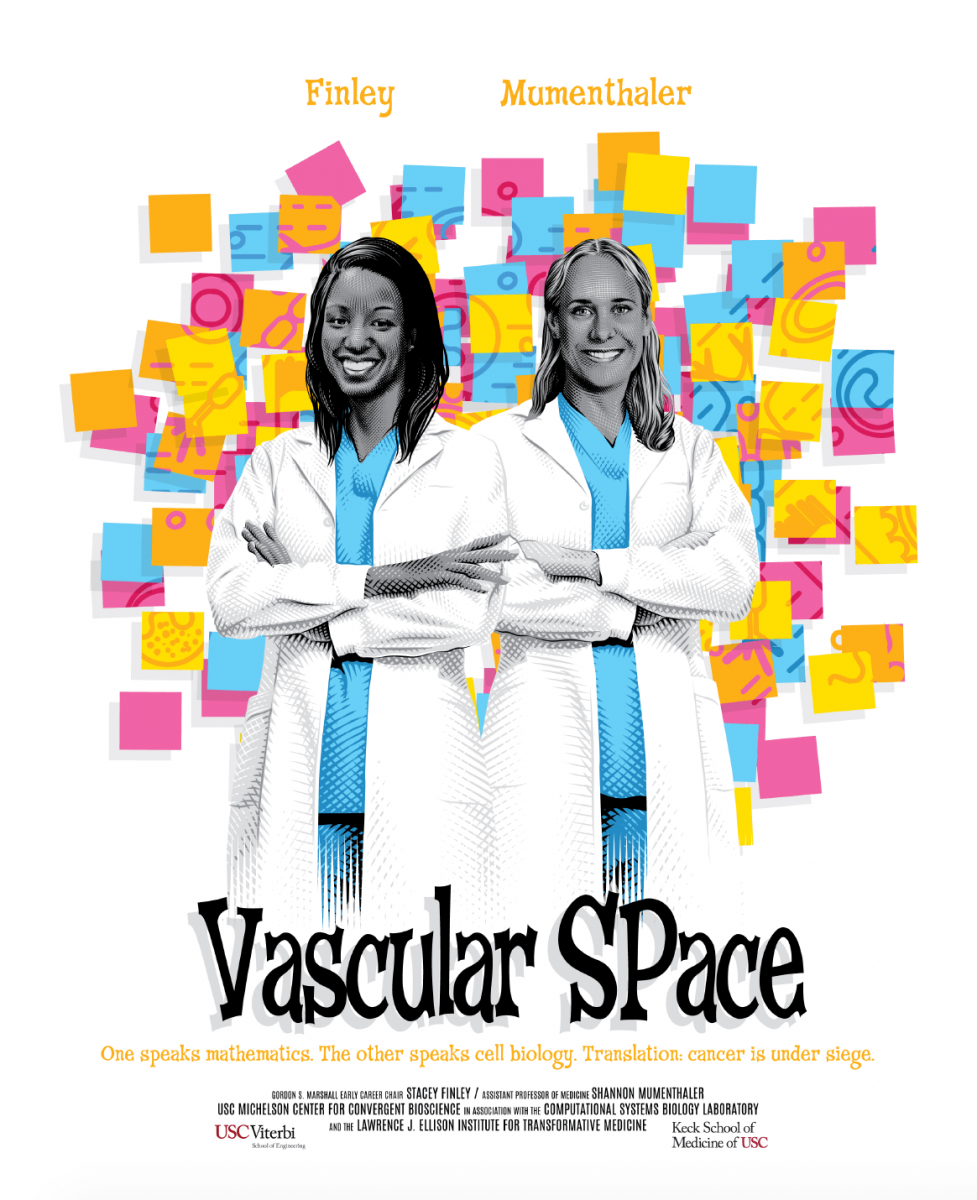
The Math Whiz and the Cell Biologist Stacey Finley and Shannon Mumenthaler
In which a biomedical engineer (Finley) joins a researcher in personalized medicine (Mumenthaler) to identify ways to starve cancer of blood and nutrients.
Unique Skill Set:
Finley: I build mathematical models of biochemical reactions inside of cells to better understand how the cells respond to cancer therapies.
Mumenthaler: I begin with cell culture systems that closely reproduce conditions in the human body. I then perform carefully measured cancer biology experiments with the help of specialized microscopes to capture images and quantify cellular behavior. My work is geared toward translating new treatments from the laboratory to the cancer patient.
Unique Personality Traits:
Finley: I have a physical day-planner (a rose gold Passion Planner) where I list all my meetings and events. I literally cannot agree to a meeting without checking that book first, which means I carry it with me all the time!
Mumenthaler: I am a sticky-note fanatic. I love to-do lists! My sticky-note volume varies, but I can have at least 10 sticky notes around my desk at a given time. Each sticky note contains a list of to-do’s or other notes to myself.
How They Met:
Mumenthaler: We met at an NCI-sponsored Physical Sciences in Oncology Center meeting in the winter of 2014. Although our first interaction was brief, we were interested in working together. Later that year, Stacey was submitting a proposal to the American Cancer Society, and she reached out to see if I would be interested in working together on the project. We met in my office to discuss the details, and that was the beginning of a fruitful collaboration of four years and counting!
Finley: One of the most exciting things about that first official meeting in Shannon’s office was that I did not have to justify why computational modeling is useful. Shannon appreciates and understands the importance of quantitative approaches, including mathematical modeling. She just gets it!
Mission:
Mumenthaler: Our mission is to develop experimentally calibrated mathematical models to address critical questions in cancer. Our main focus has been on developing a model of angiogenesis — the new development of blood vessels — that can be used to predict the efficacy of anti-angiogenic therapeutic strategies in breast cancer. These are treatments aimed at starving tumors of blood and nutrients.
Finley: We would ask Shannon to do new experiments to see if our [mathematical] model predictions hold true. This is how the model can be used to identify new treatment strategies: we predict what would happen if a reaction were turned off or if a protein is over-expressed, then test experimentally whether the model predictions are correct. The advantage of using the model is that we can try a lot of different strategies very quickly and only test experimentally the ones that are most promising.
The Stakes:
Mumenthaler: My commitment to cancer research is incredibly personal. My mother began her battle with a very rare form of breast cancer over 13 years ago, and she continues to fight every day. I have watched her endure countless therapies, with some having little to no effect. I would love to offer her a solution that would maximize her chances of receiving a therapy with a high likelihood of success.
Finley: I have had family members and loved ones deal with cancer and other life-altering, debilitating diseases. One personal motivating factor is having someone very close to me die of pancreatic cancer. Only eight weeks passed between the time he was diagnosed and his death. I try to honor his legacy by using every tool and skill I have to better understand cancer. Interdisciplinary collaboration is a powerful tool that I make use of.
Quotable:
Finley: I avoid building a model just for the sake of having one. Models are most useful when they are built with a specific biological question in mind.
Mumenthaler: Traditional cell biology experiments are often qualitative and lack context. We need to capture cellular dynamics in a quantitative and more physiologically-relevant manner.
Research success story:
Finley: One success is acquiring multiyear funding. My lab was awarded a Research Scholar Grant from the American Cancer Society in July 2017 to support our collaborative research. Shannon is co-investigator on this grant. We are actively working to build the experimentally-based model of angiogenic factors in breast cancer.




